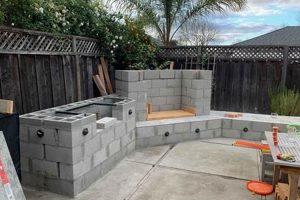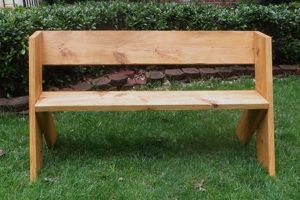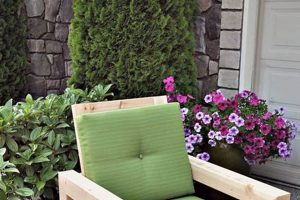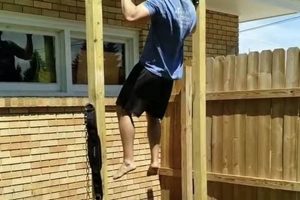Constructing storage solutions designed for exterior environments utilizing do-it-yourself methods represents a practical approach for homeowners seeking to enhance outdoor organization. These projects typically involve assembling or modifying pre-fabricated components, or building entirely from raw materials, to create weatherproof units capable of holding tools, gardening supplies, or recreational equipment. Examples include converting repurposed kitchen cabinets for patio storage or building custom cedar chests for poolside accessories.
The significance of crafting one’s own exterior storage lies in the ability to tailor the solution to specific spatial constraints and aesthetic preferences, often at a reduced cost compared to purchasing pre-made, commercially available alternatives. Historically, resourcefulness and self-sufficiency have driven individuals to create customized solutions for organizational challenges; this approach extends to addressing outdoor storage needs. Benefits include improved outdoor space functionality, protection of items from the elements, and the satisfaction derived from completing a home improvement project.
The subsequent sections will delve into essential considerations for planning, designing, and executing such projects. Crucial aspects will include material selection, construction techniques appropriate for outdoor exposure, and strategies for ensuring durability and weather resistance. Emphasis will be placed on achieving a functional and visually appealing addition to outdoor living spaces.
Essential Guidance for Exterior Storage Construction
The following guidance provides critical insights to consider before initiating outdoor cabinet construction. Thorough planning and adherence to best practices will significantly contribute to project success and longevity of the finished product.
Tip 1: Material Selection is Paramount: Opt for materials inherently resistant to moisture, insects, and UV radiation. Pressure-treated lumber, cedar, teak, and certain composite materials are suitable choices. Failure to select appropriate materials will result in premature degradation.
Tip 2: Prioritize Weatherproofing: Employ construction techniques that minimize water intrusion. This includes angled surfaces for water runoff, properly sealed joints using marine-grade sealant, and adequate ventilation to prevent moisture buildup within the cabinet.
Tip 3: Foundation and Support are Critical: Ensure a stable, level foundation to prevent warping or structural stress. Constructing a concrete pad or utilizing adjustable leveling feet are effective methods. An unstable base compromises the entire structure.
Tip 4: Implement Robust Hardware: Use stainless steel or other corrosion-resistant hardware for hinges, latches, and fasteners. Inferior hardware will quickly rust and fail, impacting functionality and aesthetics.
Tip 5: Consider Insect Control Measures: Incorporate insect screens into ventilation openings and treat lumber with borate-based preservatives to deter pests. Ignoring insect control can lead to significant structural damage over time.
Tip 6: Proper Finishing Enhances Longevity: Apply a high-quality exterior-grade paint or sealant with UV inhibitors to protect the wood from sun damage and moisture penetration. Regular reapplication is necessary to maintain protection.
Tip 7: Design for Accessibility and Functionality: Consider the intended use of the storage and design the interior layout accordingly. Shelves, drawers, and organizational accessories should be strategically placed for optimal access and efficiency.
These tips emphasize the importance of durability, weather resistance, and functionality in exterior storage construction. Careful attention to these details will result in a long-lasting and aesthetically pleasing addition to the outdoor space.
The subsequent sections will address specific design considerations and offer detailed instructions for various construction techniques.
1. Material Weather Resistance
Material weather resistance is a paramount consideration when undertaking outdoor cabinet construction. The external environment presents relentless exposure to moisture, ultraviolet radiation, temperature fluctuations, and potential pest infestation. The selection of materials directly determines the lifespan and functionality of the structure. Inadequate weather resistance leads to premature decay, structural instability, and ultimately, project failure. For example, using untreated plywood in cabinet construction exposes it to moisture absorption. The water causes warping, delamination, and eventual rotting. This renders the cabinet unusable and necessitates costly repairs or complete replacement. Therefore, employing inherently resistant materials is a foundational principle.
Durable material selection includes options such as pressure-treated lumber, known for its resistance to fungal decay and insect damage. Cedar and redwood are naturally resistant to moisture and insects due to their inherent oils. Composite materials, crafted from recycled plastics and wood fibers, offer a low-maintenance, waterproof alternative. Consider, for example, a homeowner opting for cedar to build cabinets near a coastal environment. The cedar’s natural oils protect the structure from salt spray and humidity. This selection extends the cabinet’s service life compared to using conventional, non-treated wood. Furthermore, proper surface treatments, such as marine-grade paints and sealants, enhance weather resistance by creating a barrier against moisture and UV radiation.
In conclusion, material weather resistance is non-negotiable for the success of any outdoor cabinet project. The selection of appropriate materials and protective finishes directly correlates with the structure’s longevity, functionality, and aesthetic appeal. Neglecting this crucial aspect introduces significant risk, potentially resulting in wasted resources and the need for repeated reconstruction. The long-term cost savings and sustained utility of outdoor cabinets are directly dependent on prioritizing weather-resistant materials and construction techniques.
2. Structural Integrity
Structural integrity represents a critical factor in the successful implementation of exterior storage projects. It dictates the ability of the constructed unit to withstand environmental stressors and maintain its form and function over an extended period. Compromised integrity leads to premature failure, rendering the unit unusable and potentially unsafe.
- Foundation Stability
The foundation serves as the bedrock for structural integrity. An unstable or inadequately prepared base transfers stress throughout the cabinet, leading to warping, cracking, and eventual collapse. For example, cabinets placed on uneven ground experience disproportionate weight distribution, accelerating deterioration of joints and frame members. A properly constructed, level foundation is essential for distributing load evenly and preventing structural strain.
- Joinery Techniques
The methods used to join individual components significantly impact overall strength. Weak or improperly executed joinery compromises the cabinet’s ability to resist external forces. Simple butt joints held together with nails or screws lack the necessary shear strength to withstand prolonged exposure to wind, moisture, and heavy loads. Robust joinery techniques, such as mortise and tenon, dovetail, or rabbet joints reinforced with adhesive, provide superior structural stability.
- Material Selection and Load Capacity
The type and thickness of the materials used must be appropriate for the intended load. Substandard lumber or insufficient bracing results in sagging shelves, buckling panels, and ultimately, structural failure. Cabinets designed to store heavy items, such as gardening tools or power equipment, require thicker lumber, reinforced shelves, and strategically placed supports to distribute weight evenly and prevent deformation.
- Resistance to Environmental Factors
Beyond static load capacity, structural integrity also encompasses resistance to environmental degradation. Moisture penetration, insect infestation, and ultraviolet radiation weaken wood fibers and compromise the cabinet’s structural components. Employing weather-resistant materials, proper sealing techniques, and protective finishes mitigates these risks, preserving the cabinet’s strength and extending its lifespan.
In summary, structural integrity is not merely an aesthetic consideration; it is the fundamental principle underpinning the durability and longevity of exterior storage solutions. Addressing the foundation, joinery, material selection, and environmental resistance ensures the cabinet can effectively withstand the rigors of outdoor exposure and provide reliable storage for years to come.
3. Ergonomic Accessibility
Ergonomic accessibility, when applied to the construction of exterior storage solutions, directly influences the ease of use, safety, and overall satisfaction derived from the finished product. The design and placement of such units must consider the user’s physical capabilities and limitations to ensure comfortable and efficient interaction.
- Optimized Height and Reach
Cabinet height significantly affects accessibility. Units that are too tall require excessive reaching, potentially leading to strain or falls. Conversely, cabinets positioned too low necessitate bending, causing discomfort and potential back injuries. A design that incorporates adjustable shelving or varying compartment heights accommodates users of different statures and maximizes accessible storage space for diverse items. An example would be setting the primary work surface of an outdoor potting bench at counter height (approximately 36 inches) to minimize strain on the back during extended use.
- Door and Drawer Mechanisms
The operation of doors and drawers directly impacts ease of access. Heavy doors or drawers that require significant force to open can be problematic for individuals with limited strength or mobility. Implementing smooth-gliding drawer slides and lightweight door materials reduces the effort required for operation. Magnetic latches or soft-close hinges prevent slamming and ensure controlled closure, minimizing the risk of injury. Consider a cabinet with full-extension drawer slides, allowing complete access to the contents of the drawer without the need to reach into the back, thereby improving efficiency and reducing physical strain.
- Internal Organization and Layout
The interior layout of the cabinet should promote efficient storage and retrieval of items. Cluttered or poorly organized storage spaces increase the effort required to locate and access desired items. The strategic placement of shelves, drawers, and dividers allows for categorization and easy identification of contents. For example, incorporating vertical dividers for storing long-handled tools or adjustable shelves for accommodating items of varying heights optimizes space utilization and minimizes the need to rearrange items to access specific objects.
- Clear Pathways and Maneuvering Space
The location of the cabinet within the outdoor environment must account for sufficient maneuvering space. Obstacles or narrow pathways can impede access and increase the risk of accidents. Ensure that there is adequate space for users to safely approach and interact with the cabinet, even when carrying items. Integrating the cabinet into an open area or widening pathways leading to the cabinet enhances accessibility and reduces potential hazards. Consider a patio layout that provides ample space for wheelchair users to access outdoor storage without obstruction.
By integrating ergonomic principles into the design and construction process, exterior storage solutions can be tailored to meet the specific needs of the user, promoting comfort, safety, and efficiency. Failing to prioritize ergonomic accessibility can result in units that are cumbersome to use, potentially leading to injury or decreased utility. Therefore, careful consideration of these factors is essential for maximizing the value and usability of outdoor cabinets.
4. Design Aesthetics
The application of design aesthetics to outdoor cabinet construction significantly influences the perceived value and integration of these structures within the broader landscape. The aesthetic considerations are not merely superficial; they directly impact how the cabinets harmonize with existing architectural elements, contribute to the overall ambiance of the outdoor space, and reflect the homeowner’s personal style. A well-designed cabinet enhances the visual appeal of the surrounding environment, while a poorly designed one can detract from it, regardless of its functional utility. For example, a cabinet constructed from repurposed shipping pallets may offer ample storage space, but its rough-hewn appearance might clash with the refined aesthetic of a manicured garden or a modern patio. The cause-and-effect relationship is clear: deliberate aesthetic planning yields an appealing result, while neglect results in visual discord.
The practical significance of understanding design aesthetics lies in the ability to create outdoor storage solutions that seamlessly blend into their surroundings. This involves careful consideration of various elements, including material selection, color palettes, hardware choices, and overall form. The material choice dictates the texture and visual weight of the cabinet. A cabinet constructed from reclaimed wood offers a rustic and warm aesthetic, while one built from stainless steel conveys a modern and industrial feel. Color palettes influence the cabinet’s visibility and its relationship to surrounding elements. A cabinet painted in neutral tones blends seamlessly into the background, while one in bold colors draws attention and serves as a focal point. The hardware selected also impacts the aesthetic impression. Decorative pulls and hinges add a touch of elegance, while minimalist hardware creates a clean and modern look. Overall form and proportions should complement the architectural style of the house and the surrounding landscape. A cabinet with clean lines and geometric shapes suits a contemporary home, while one with curved lines and ornate details complements a traditional one.
In conclusion, design aesthetics constitute an integral component of successful outdoor cabinet construction. It is the fusion of functionality with visual appeal that transforms a mere storage unit into an integrated element of the outdoor living space. The challenge lies in balancing practical storage needs with aesthetic considerations to create a solution that is both functional and visually pleasing. By understanding the principles of design and applying them thoughtfully, homeowners can create outdoor cabinets that enhance the beauty and value of their properties. Ignoring the aesthetic dimension diminishes the potential of the project and results in a functional object that does not contribute positively to its surroundings.
5. Weatherproofing techniques
The longevity and functionality of self-constructed outdoor cabinets are inextricably linked to the application of effective weatherproofing techniques. Without proper protection against environmental elements, the structural integrity and aesthetic appeal of these units rapidly deteriorate, negating the initial investment of time and resources. The relationship between weatherproofing and durability is causal: inadequate protection directly leads to moisture damage, insect infestation, and eventual structural failure. For instance, cabinets constructed using untreated lumber and lacking proper sealing are highly susceptible to water absorption, which promotes fungal growth and decay. In contrast, projects employing pressure-treated lumber, marine-grade sealants, and effective drainage systems exhibit significantly extended lifespans, even under harsh environmental conditions.
The practical application of weatherproofing principles extends beyond mere material selection. It encompasses construction techniques that minimize water penetration and promote adequate ventilation. Angled surfaces facilitate water runoff, preventing pooling on horizontal surfaces. Overlapping joints and drip edges divert water away from vulnerable areas. The inclusion of ventilation openings, strategically placed to prevent the entry of rain and snow, allows for air circulation, which inhibits moisture buildup inside the cabinet. For example, creating a slight overhang on the cabinet roof directs water away from the cabinet’s sides, reducing the exposure of joints and seams to rain. Similarly, incorporating screened vents near the base and top of the cabinet facilitates airflow, preventing condensation and reducing the risk of mold growth. Regular maintenance, including periodic inspections and reapplication of sealants or paints, is also vital for sustained protection.
In summary, weatherproofing techniques represent a crucial and indispensable component of successful outdoor cabinet construction. The challenges inherent in combating the relentless forces of nature require a proactive and comprehensive approach, encompassing material selection, construction methodologies, and ongoing maintenance. The practical significance of understanding and implementing these techniques lies in safeguarding the investment, extending the cabinet’s lifespan, and ensuring its continued functionality as a valuable addition to the outdoor living space. Without proper weatherproofing, the project becomes a liability, requiring frequent repairs or eventual replacement, thereby undermining the purpose of self-construction: creating a durable and cost-effective storage solution.
Frequently Asked Questions
The following questions address common concerns regarding the design, construction, and maintenance of outdoor storage solutions.
Question 1: What constitutes the most durable material choice for exterior cabinets?
Durable material choices include pressure-treated lumber, cedar, teak, and certain composite materials engineered for outdoor use. These materials exhibit resistance to moisture, insect infestation, and UV degradation. Proper selection significantly impacts the lifespan of the constructed unit.
Question 2: What foundational elements ensure the stability of outdoor cabinets?
Ensuring stability requires a level and stable foundation. This may involve constructing a concrete pad, utilizing adjustable leveling feet, or building upon an existing solid surface. An unstable foundation compromises the structural integrity of the entire cabinet.
Question 3: How does one effectively weatherproof joints in exterior cabinet construction?
Effective weatherproofing of joints necessitates the use of marine-grade sealants specifically formulated for outdoor applications. Applying sealant to all seams and joints prevents water penetration and minimizes the risk of rot or decay.
Question 4: What strategies mitigate insect infestation in wooden outdoor cabinets?
Insect control measures include treating lumber with borate-based preservatives, incorporating insect screens into ventilation openings, and maintaining a clean environment around the cabinet. These steps deter pests and prevent structural damage.
Question 5: How frequently should exterior cabinets receive sealant or paint reapplication?
The frequency of reapplication depends on environmental conditions and the type of finish used. Generally, inspecting and reapplying sealant or paint every one to two years is recommended to maintain optimal protection against the elements.
Question 6: What design considerations enhance ergonomic accessibility in outdoor storage solutions?
Ergonomic design incorporates appropriate cabinet height, easy-to-operate door and drawer mechanisms, and strategic internal organization. These elements promote comfortable and efficient use of the storage unit.
Understanding these key aspects is crucial for successfully constructing durable, functional, and aesthetically pleasing exterior storage solutions.
The subsequent sections will explore advanced construction techniques and offer detailed instructions for specific projects.
Outdoor Cabinets DIY
This exploration has detailed the multifaceted nature of constructing outdoor cabinets. Key considerations include material selection predicated on weather resistance, structural integrity assured through robust joinery, ergonomic accessibility that promotes ease of use, design aesthetics for visual harmony, and weatherproofing techniques to mitigate environmental damage. These elements, when thoughtfully integrated, contribute to the creation of durable and functional exterior storage solutions.
The successful implementation of such projects requires a commitment to quality and a meticulous approach. Prudent planning and diligent execution not only enhance the utility of outdoor spaces but also represent a tangible investment in property value. The continued refinement of construction methodologies and the exploration of innovative materials will undoubtedly shape the future of exterior storage, providing homeowners with ever more resilient and aesthetically pleasing options. Careful planning and responsible execution provides long-term benefits and value.







